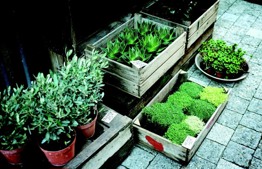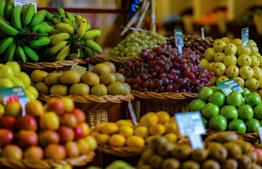Orlah, Chapter 3a: What is a tree?

The halachic definition of tree vs. vegetables vis-à-vis orlah includes various criteria. An overview of the Talmudic criteria as well as those added by Rishonim and Acharonim. Also, a look at those plants don't fit neatly into a specific category.
- The Torah states "and you plant any tree for food" (Vayikra 19:23), which teaches us that only "fruit trees" are subject to the orlah prohibition, but not vegetables.[1]
- According to halacha, the main criterion that determines whether a plant is considered a tree or vegetable is the length of plant life and the way in which new branches grow. Perennial plants that renew from the trunk are considered trees. In contrast, annuals or perennials that renew from the root are considered vegetables.[2] In this context, the root is considered that part of the plant that is beneath the soil.[3] For example: although banana trees are perennial and can last for many years, the individual stalk renews from the root—so they are considered vegetables.
- While there are additional criteria used to define plants as either vegetables or trees mentioned by the poskim, they are subject to dispute (as detailed below).
- Some poskim maintain that plants with a hollow trunk are considered vegetables, even though they are perennial and renew from the trunk. However, we do not rely solely on this criterion. Examples of such plants with hollow trunks include eggplant, papaya, and babaco.[4]
- Some hold that perennials that do not live for more than three years are considered vegetables;[5] other poskim hold that if the quality and quantity of the yield decreases from year to year,[6] the plant is a vegetable. In practice, we rely on these two conditions when they appear together.[7] For example, an eggplant is considered a vegetable and is not bound by the orlah prohibition since these two conditions exist.
- There are poskim who hold that a plant that bears fruit within a year of planting is considered a vegetable, so orlah laws would not apply.[8] This is the ruling of most the contemporary Sephardic [9] Many poskim, however, do not accept this leniency since it is not cited by either Talmud Bavli or Yerushalmi.[10] Examples of such plants include: papaya, babaco, passionfruit and goji berries. Note that when papaya and passionfruit are sold fresh bearing a regular rabbinate certification (and not mehadrin), it relies on this lenient opinion.
- Those who are lenient and classify certain plants as vegetables according to the criteria mentioned in sections 5–6 above, have what to rely on. This is as long as these qualities are manifested by the plants in their natural habitat. For example, a plant that does not live for three years in the Land of Israel, but in its country of origin it can survive for several decades, will certainly be considered a tree and not a vegetable.[11]
- Hot peppers are considered vegetables, so they are not bound by orlah[12]
- Hot peppers known in Israel as pilpel sudani ("Sudandese pepper") live for many years and the quantity and quality of the yield does not deteriorate over time. For this reason, they are considered trees and are subject to orlah However, there are those who nevertheless consider them vegetables, since the bush bears fruit within the first year of planting.[13]
- Passionfruit is similar to the Sudanese pepper, and is subject to orlah Others exempt it from orlah because it gives fruit within a year.[14]
- The pitaya (or dragon fruit, from the cactus family) possesses a unique characteristic: it can exist without soil, since it has aerial roots that can wrap around trellis poles (even metallic ones). It receives its nourishment from liquids and misters. At the same time, the plant has all of the characteristics of a tree. For this reason, if it is planted in the soil, it is treated halachically like a tree and thus is bound by orlah However, if grown aeroponically and not at all planted in the ground, it is exempt from orlah.[15]
- Raspberries are considered vegetables, since they renew from shoots (canes) that grow from the roots, a small distance from the original biannual cane. At times, there are even canes that sprout as lateral shoots from the base. In any case, each cane lives for two fruiting seasons and then shrivels up and dies.[16]
- Sugar cane also renews from the base, but the majority of the Ge'onim and Rishonim consider it a tree.[17] Nevertheless, it is not bound by orlah prohibitions, because the fruit is not eaten; only the water or sap that it excretes.[18]
The sabra (prickly pear) cactus is considered a tree. It is bound by orlah laws unless planted as a living fenc
[2] Rambam, Hilchot Kila'im 5:19–20; on the definitions of trees and vegetables, see Rabbi Yoel Friedemann, "Defining trees and vegetables in halacha" in HaTorah VeHa'aretz III (5757) pp. 398-428; and his dissertation, "The development of the definition of trees and vegetables from Tana'itic literature through 17th-century halachic decisors," Tevet 5766, master's thesis for the Department of Talmud and Oral Law, Bar Ilan University (Heb.).
[4] Halachot Ketanot I §83. Note that eggplant is considered a vegetable for other reasons, and the papaya and babaco are also considered vegetables by some poskim for other reasons as well.
[5] Chazon Ish, Orlah §12:3, incipit vanir'eh degeza; however, Kaftor Vaferach, chap. 56 and Radbaz III §531 (566); ibid.; I §563; ibid., IV §296 (1368), disagree and maintain that even if the plant does not live for three years it nevertheless is considered a tree and will always be prohibited.
[6] Maharam Alshich, qtd. by Birkei Yosef YD §294:4.
[7] Chazon Ish, Orlah §12:3, incipit venireh ledina.
[8] Radbaz III §531 (566), at the end of the responsum.
[9] Birkei Yosef, ibid.; Rav Pe'alim, OC II §30; Yayin HaTov, YD §14; Yechaveh Da'at II §21, IV §52; Rabbi Mordechai Eliahu, "Papaya—tree or vegetable?" Techumin 7 (5746), pp. 88–93. See also Ish Matzliach, II §45, who disagrees.
[10] Chazon Ish, ibid.; Ish Matzliach, ibid.
[11] See Yechaveh Da'at IV §52 (see note on p. 267), who was inclined to be lenient based on the characteristics of the tree in its country of origin. It is obvious that one should be stringent based on the tree's characteristics in its natural habitat, especially since the practical halachic difference under discussion concerns not only orlah. This also has ramifications on the laws of blessings, which are relevant also outside the Land of Israel. This is also the position of Kerem Tziyon, Hilchot Orlah, (5743), chap. 4, n. 4, pp.12–13.
[12] Rabbi Yoel Friedemann, "The hot pepper – tree or vegetable?" HaTorah VeHa'aretz (5760) V, pp. 139–142.
[13] See letter by Rabbi Mordechai Eliahu, Emunat Itecha 10 (5756), p.6 and Yechaveh Da'at IV §52 (see note on p. 267). They maintain that this condition is sufficient for the plant to be considered a vegetable.
[14] Meir Frankel and Rabbi Yoel Friedemann, "Passionfruit – subject to orlah?" HaTorah VeHa'aretz V (5760), pp. 143–145; see also Chelkat HaSadeh, Zera'im I (5759), pp. 74–83.
[15] See the article by Rabbi Yehuda Amichay, "Petaya," Techumin 26 (5766), from p. 57 on and see response by Rabbi Shlomo Amar, Techumin, ibid., from p. 61 on. However, since not planted in the soil, trees that grow entirely aeroponically are exempt from orlah laws. See Rabbi Yaakov Ariel, "Terumot and ma'aserot for sprouts", HaTorah VeHa'aretz IV (5759), pp. 35–36, who rules that a plant growing aeroponically is not considered sown or having taken root. Regarding the definition of "planting" vis-à-vis orlah obligation, see Rabbi Yoel Friedemann, "The significance of grafting vis-à-vis orlah," HaTorah VeHa'aretz I (5749), section 4, pp. 93–97.
[16] This is the ruling of Rabbi Mordechai Eliahu, Rabbi Yaakov Ariel and Rabbi Yehuda Amichay. Rabbi Ariel notes that this plant does not have a trunk. See Tosefta Kila'im, ibid. See Rabbi Yoel Friedemann, "The raspberry – tree or vegetable vis-à-vis orlah," Emunat Itecha 99 (5773), pp. 78–83 and Dr. Mordechai Shomron, "Raspberry, blackberry, and blueberry – tree or vegetable?" Emunat Itecha 97 (5773), pp. 48–52. It is my humble opinion (Y.F.) that further research is necessary on the topic in light of the Rashba III §237 (see chapter 5.11 n. 107), who holds that shoots emerging from the roots (root suckers) are obligated in orlah only miderabanan. This means that mide'oraita, each root sucker is not an independent plant, and that the plant in its entirety does live for more than three years.
[17] Rabbi Yoel Friedemann, "Kedushat shevi'it for sugar cane," HaTorah VeHa'aretz VIII (5768), pp. 102–111.
[18] Radbaz I §563, III §531 (566).




